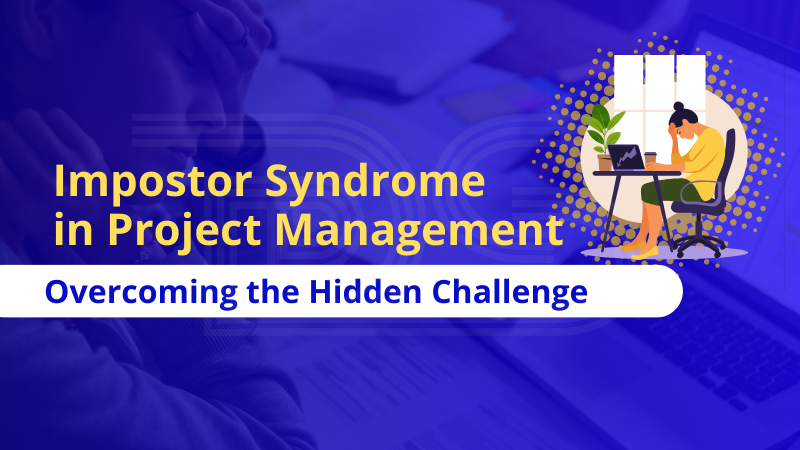
by admin | Jan 10, 2025 | Professional Resilience and Inspiration Stories
Impostor syndrome is a psychological disorder where individuals mistrust their abilities, leading to decreased productivity, increased stress, anxiety, and work satisfaction. IT project managers often experience this issue, distrusting their team’s communication, leadership, and decision-making abilities.
This article explores the causes of impostor syndrome in project management, its psychological and professional impact, and actionable strategies to overcome it.
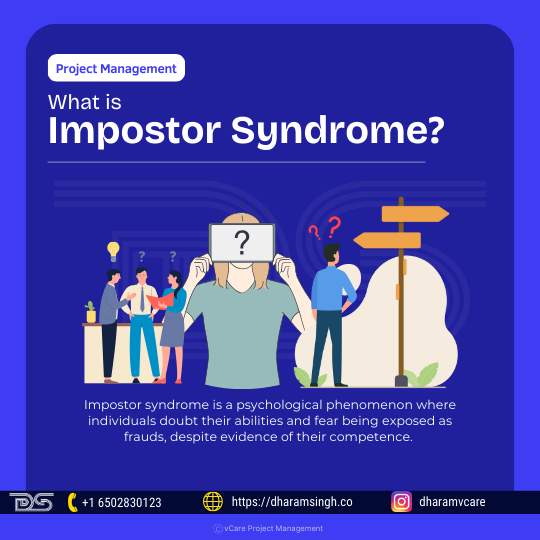
What is Impostor syndrome?
Project management awareness of Impostor syndrome
Project managers frequently feel like frauds, despite their accomplishments. The impostor syndrome causes people to distrust themselves. They’re worried about disappointing their teammates. It stems from the high expectations in project management. The term “impostor syndrome” was coined by Pauline Clance and Suzanne Imes, to describe chronic self-doubt, dread of failure, and the conviction that achievement is due to luck or fortunate timing. It is a major professional difficulty in project management, affecting performance, decision-making, and team relations.
A KPMG: Women’s Leadership study found that 75% of female executives experienced impostor syndrome, with project managers being particularly vulnerable.
Why It Matters in Project, Program, and Portfolio Management
Project, program, and portfolio managers are important to the performance of organizations, which makes impostor syndrome crucial. It is concerned with making certain that strategic projects are properly carried out and completed effectively, on schedule, and within budget. These professionals’ roles typically expose them to scrutiny from team members, senior leadership, and stakeholders; as a result, self-doubt can have disastrous consequences.
General reasons why the impostor syndrome is important in this discipline include:
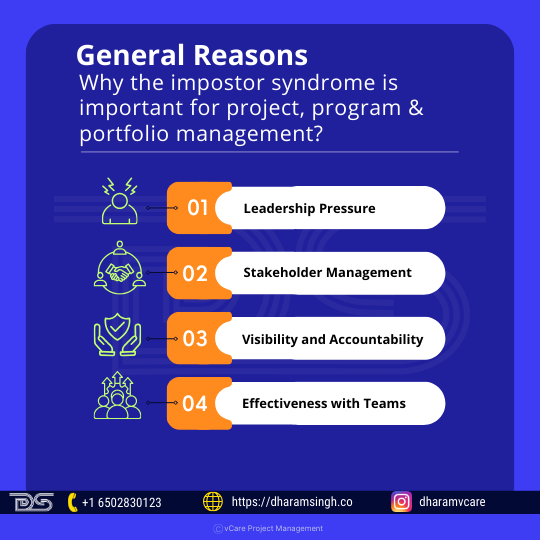
General reasons why the impostor syndrome is important Project, Program, and Portfolio Management?
- Leadership Pressure: The managers of a project are considered decision-makers and problem solvers. Hesitation and loss of confidence can undermine leadership authority and destroy team trust.
- Stakeholder Management: Stakeholder management requires assertive communication about managing expectations from clients, sponsors, and cross-functional teams. Impostor syndrome creates second-guessing abilities to meet the expectations of stakeholders.
- Visibility and accountability: Project managers function under very visible conditions that exhibit success and failure intensely, and the more successful one of these projects is, the further it raises the reputation, or the worse, failing it may attract public attention in creating self-doubting notions.
- Effectiveness with Teams: The inadequacies of a project manager have a ripple effect on those teams, thus influencing their confidence and productivity.
Identifying Its Challenges in High-Stakes Situations
The high stakes of project management provide the perfect breeding ground for impostor syndrome. Here’s why:
- Project Managers’ Multifaceted Function
A project manager can serve a range of roles, including leader, planner, communicator, mediator, and risk management. Even professionals may feel inadequate at times due to the diversity of roles.
- Fast-paced and Changing Work Environments
The project management field evolves with new methodologies such as Agile, Lean, and Six Sigma, tools, and technologies. In this setting, one cannot keep up to date, and in the attempt to transition from traditional ways of handling project management, one is always left inadequate. Fast-paced changes in priorities with very short deadlines don’t help as well and just amplify self-doubt by squeezing little time for error.
- The Need for Perfectionism
Usually, project managers fall prey to the pressure of being perfect and over prepare or fear delegation. Perfection emerges because he believes that if he fails, everyone else will expose his ineptness.
- Cultural and Gender Dynamics
Cultural expectations, such as respect for authority or not wanting to boast, can heighten impostor syndrome. In some cultures, voicing doubts or seeking assistance is perceived as a sign of weakness. Women and minorities in project management positions experience impostor syndrome more keenly because of systemic biases and underrepresentation in leadership roles.
- Dynamic Stakeholder Relationships
It is particularly difficult to manage relationships with stakeholders that have divergent expectations or interests. The urge to constantly “prove themselves” is a common one among project managers, particularly in politically heated workplaces.
Signs of Impostor Syndrome in Project Managers
- Deny receiving compliments or explain success away using outside reasons.
- Desperation to prove one’s work: This involves seeking self-validation through peer or third parties’ validation.
- They avoid risky tasks or roles/positions.
- Work overtime or exert excessive efforts just to correct imagined deficiencies.
- Successes occurred by chance or good fortune.
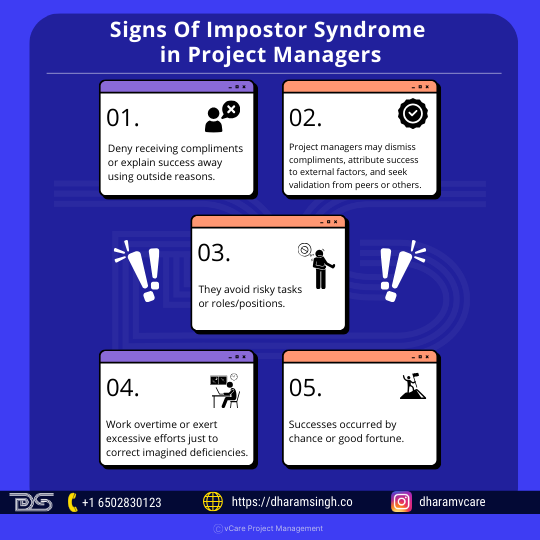
Signs of Impostor Syndrome in Project Managers
Once such understanding is gained about the nature of impostor syndrome and the specific challenges it brings in project management, it would be easier for professionals to take the first step toward resolution. Identifying such feelings early and acknowledging the fact that many people experience them will help lay the foundation for self-doubt and building confidence in their roles.
The Psychological Toll: Emotional and Professional Impacts
Impostor syndrome can significantly affect the psychological well-being and performance at work of project managers. The fear of being exposed as incompetent despite evidence to the contrary leads to the perpetuation of self-doubting, overcompensating, and eventually burnout. It is, therefore, essential to understand in detail the impacts that may lead to addressing the challenges imposed by impostor syndrome.
Psychological Effects of Impostor Syndrome
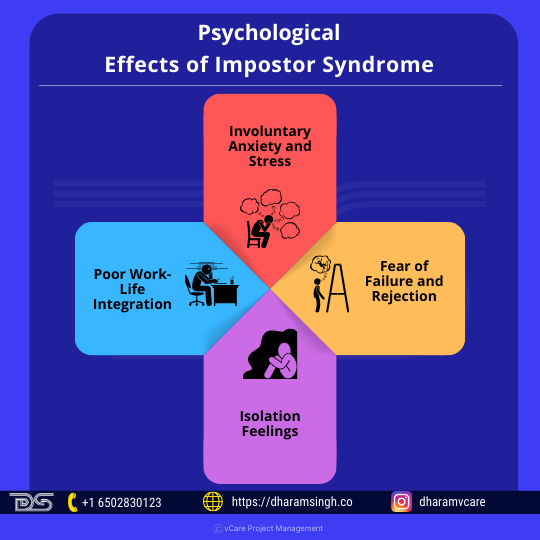
Psychological Effects of Impostor Syndrome
- Involuntary Anxiety and Stress
Continuous fear of failure and “being caught out” will also often create chronic anxiety. Project managers may obsessively worry over meeting the time deadlines, pleasing the stakeholders, or dealing with any other emergent obstacles.
Such higher levels of stress may also manifest in the body. They could be plagued with insomnia, headaches, and even more fatigue which lowers their ability to perform.
- Fear of Failure and Rejection
Most project managers with impostor syndrome fear taking risks or presenting new solutions because those might get them wrong. This often hinders creativity and prevents full potential use and, thus, often leads to missed opportunities for growth at both the personal and team levels.
- Isolation Feelings
Impostor syndrome patients generally feel lonely. They might think that others and even their superiors are much better and more confident, which generally proves to be wrong. Such isolation may lower the level of motivation to ask for help or to share responsibility and thereby intensify the pressure on them.
- Poor Work-Life Integration
Many project managers end up suffering from poor work-life integration by working long hours due to the urge to prove themselves. Poor relationships with personal lives may lead to this integration and even decrease job satisfaction. It turns out to be a vicious cycle of dissatisfaction and self-doubt.
Professional Outcomes of Impostor Syndrome
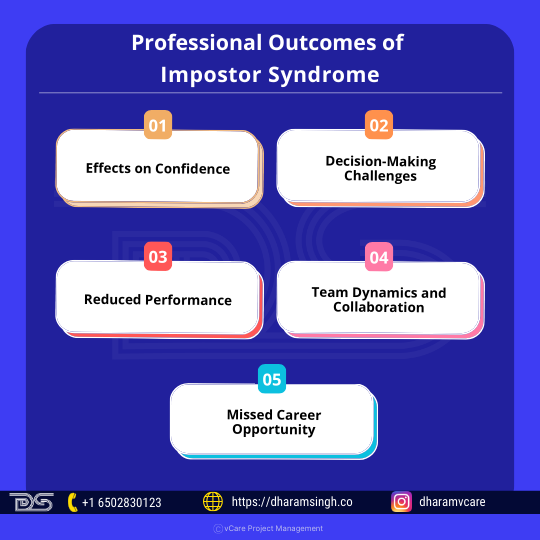
Professional Outcomes of Impostor Syndrome
- Effects on Confidence
Impostor syndrome consumes self-confidence because the project managers start doubting their decisions. For example, they may not advance new ideas in meetings, or they may deny getting credit for the success. Lack of confidence also makes leadership hard to achieve because other team members look up for direction and reassurance to their manager.
- Decision-Making Challenges
Decision paralysis is often the result of the fear of making mistakes. Project managers may delay critical decisions, seeking excessive validation or overanalyzing data to avoid potential criticism. Alternatively, they may make overly cautious decisions that limit the project’s potential, prioritizing “safe” outcomes over innovative solutions.
- Reduced Performance
Over-preparation and perfectionism, which are prominent signs of impostor syndrome, can deplete time and energy that could be better spent on strategic goals. For example, a project manager may spend hours preparing a presentation slide rather than addressing a serious resource allocation issue.
- Team Dynamics and Collaboration
Impostor syndrome can damage team trust and morale. When project managers fail to distribute duties because they lack confidence in their leadership, team members may experience micromanagement, inefficiency, and frustration. Too critical of themselves as managers create impossible goals for a team. Pressure is also unnecessary and not productive.
- Missed Career Opportunity
Those affected by impostor syndrome feel incapable of becoming leaders or take risky projects where they would appear less prepared, or they were not competent enough. The career of such a person will reach a stagnating state, while their profile is dropped lower in an organization than deserved; they already have all the skills and expertise.
To break out of the emotional and professional impacts of impostor syndrome, project managers can use strategies that include:
- Become more mindful of yourself: Recognize and acknowledge the existence of impostor syndrome symptoms.
- Reframe negative thoughts: Adopt a development attitude, which views failures as teaching opportunities, in place of a self-doubting perspective.
- Seek mentorship: Spend time with mentors or peers who could guide, support, and give critical feedback.
- Celebrating Achievements: Find time to reflect on and appreciate successes regardless of the magnitude.
Addressing the emotional and professional toll of impostor syndrome in project managers can only make the manager perform better while building healthier, more productive team dynamics. Recognizing self-doubt as an ordinary rather than failing on personal levels is the first step toward overcoming its effects.
Root Causes: Triggers in High-Stakes Environments
Impostor syndrome seems to come out of the blue. It is often caused by characteristics prevalent in competitive situations such as project, program, and portfolio management. The factors that lead to these triggers shed light on why impostor syndrome occurs and how it can be effectively managed.
Factors that contribute to impostor syndrome in highly competitive industries
- High expectations and pressure to perform
Highly competitive industries require a high level of performance under time pressure and innovation. Project managers are often faced with strict performance requirements that leave no room for error.
- Technological aspects
In areas such as technology or finance, the increasing need to keep up with the latest tools, trends, and methods threatens even experienced professionals with obsolescence and under-qualification.
- Complexity of stakeholder relationships
The need to oversee multiple stakeholders with conflicting interests exacerbates this problem. To win over stakeholders, project managers often have to “prove” themselves repeatedly.
This problem is particularly prevalent in matrix organizations where project managers need to communicate simultaneously with senior executives, cross-functional teams, and external suppliers.
- Stereotypes and systemic biases
Women, minorities, and other disadvantaged groups in leadership positions may find it more difficult to overcome impostor syndrome due to systemic biases and preconceived conceptions.
- Cultural norms
In certain cultures, humility and respect for authority are more important than self-promotion. Individuals from these backgrounds may struggle to accept their accomplishments, leading to feelings of inadequacy.
How organizational culture and dynamics exacerbate Impostor Syndrome?
- Lack of recognition and feedback
In organizations where there is little recognition of success or feedback, project managers can begin to question their usefulness and competence. A culture where only performance is measured and not individual contribution can lead to employees becoming replaceable parts rather than valued team members.
- Unhealthy competitiveness
An overly competitive environment encourages individuals to compete with and even against their peers, fostering a zero-sum worldview. In cases where promotions or bonuses are limited, the pressure to outperform others leads to anxiety and self-doubt about one’s abilities.
- Toxic leadership qualities
Leaders who micromanage, overly criticize, or fail to support their teams create a culture of fear and uncertainty. A project manager working in such a scenario feels that everything they do is being watched, which increases their fear of making mistakes.
- Undefined roles
Unclear roles and responsibilities can lead to impostor syndrome. For example, if expectations are not defined, professionals may feel unqualified even though they perform well. A project manager who is also entrusted with technical tasks without receiving appropriate training may feel inadequate in his or her management skills, even though he or she manages well.
- The emphasis on perfectionism
Organizations that reward perfection and punish mistakes create a culture where mistakes are feared. Project managers would overwork themselves or be afraid to let go because they feel that any mistake would affect their performance.
Real-world example: impact of organizational culture
- Scenario: A company transitioning to agile methods puts a lot of pressure on its managers to adapt quickly and deliver fast.
- Trigger: Most training courses offer little practical support or mentoring to prepare project managers for these tasks.
- Result: Many managers feel unable to lead agile teams, despite having relevant knowledge and experience from traditional project management.
- Exacerbation: Poor, unhelpful early iterations offer little constructive feedback and perpetuate these feelings, often increasing stress and reducing productivity.
When the company introduced a coaching system with continuous guidance from experienced Agile practitioners, managers gained more confidence in their roles, and project results improved.
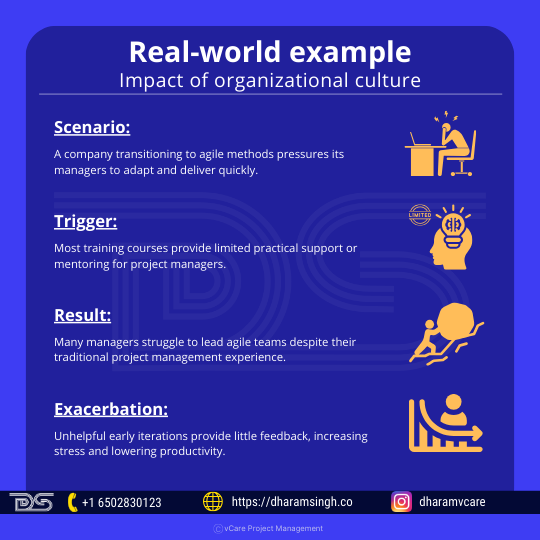
Real-world example: impact of organizational culture
Overcoming the triggers
Organizations and individuals can overcome these triggers by creating a supportive and inclusive environment:
- Encourage continuous learning
Set up training programs and professional development activities to help project managers learn the ever-changing needs of the industry.
- Recognition and feedback
This can be encouraged through a culture of regular constructive feedback and celebration of individual and team achievements.
- Develop an inclusive leadership culture:
Leaders need to be trained to make teams feel safe, heard, and valued.
- Roles and expectations
Ensure that project leaders know what is expected of them and how many resources they have at their disposal.
- Redefining failure
Change the organization’s mindset by no longer viewing failure as a symbol of weakness but as an opportunity to learn.
This understanding of the origin of impostor syndrome in a pressured setting benefits the organization. They can assist project managers overcome self-doubt, but they also foster a culture of resilience, innovation, and collaboration.
Striking the Balance: Confidence and a Growth Mindset
Project managers who struggle with impostor syndrome must strike a balance between confidence and a growth mindset. A growth mindset promotes ongoing learning and development, while confidence gives you the certainty to act. Professionals can embrace difficulties, grow from failures, and perform well under pressure when these qualities are combined.
Fostering a Growth Mindset While Maintaining Confidence
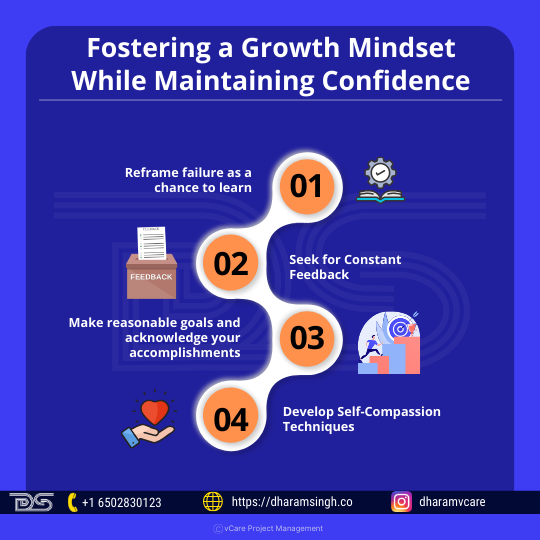
Fostering a Growth Mindset While Maintaining Confidence
- Reframe failure as a chance to learn
A growth mindset considers challenges and failures as opportunities for progress. Team members and leaders may help normalize failure by examining what went wrong and using it to guide future choices. For instance, instead of concentrating only on bad results, project managers might emphasize lessons learned from mistakes during post-project reviews.
- Seek for Constant Feedback
Frequent feedback promotes progress by pointing out blind spots and areas that need work. However, positive reinforcement increases self-esteem by recognizing achievements.
Establish organized feedback loops in teams, such as 360-degree reviews or weekly check-ins, to balance appreciation and constructive criticism.
- Make reasonable goals and acknowledge your accomplishments
Confidence can be damaged by unrealistic goals, particularly when they don’t yield the desired outcomes. Establishing modest objectives gives one a sense of achievement and increases self-confidence. For example: Break major project goals into more manageable, quantifiable tasks, then celebrate when they are finished.
- Develop Self-Compassion Techniques
People who suffer from impostor syndrome frequently criticize themselves severely. A kinder, more encouraging approach to personal growth is made possible by engaging in self-compassion practices.
To combat negative self-talk and keep perspective on failures, employ mindfulness techniques or affirmations.
Turning Impostor Syndrome into a Driver for Improvement
- Recognize Inspiring Impostor Thoughts
Instead of stifling self-doubt, take it as a lesson to be well-prepared and to aim for perfection. For instance, a project manager can focus their efforts on learning more, improving their skills, or looking for mentoring if they feel unqualified for a position.
- Prioritize learning and effort above results
The process is more important to a growth mindset than the outcome. Fear of failure declines when attention is directed toward one’s work and growth. For instance, a manager might concentrate on how much their team has developed or changed over the project rather than focusing on achieving all KPIs.
- Stress Collaborative Development
Project managers may establish cooperative, encouraging workplaces by cultivating empathy for others’ hardships through impostor syndrome. To build trust and promote group problem-solving, share personal experiences of uncertainty with team members.
- Take on Perfectionism
Impostor syndrome is significantly influenced by perfectionism. Professionals can achieve more sustained growth by adopting a “progress over perfection” mindset instead of a “perfect or bust” one. For example: To feel successful, celebrate small achievements along the way rather than waiting for a perfect end product.
Balancing confidence with a growth attitude enables project managers to change impostor syndrome from a limiting understanding to a success driver. Organizations may help individuals reach their full potential by creating a supportive culture that promotes development, learning, and empathy.
Real-World Insights: Overcoming Impostor Syndrome
Important things to know about project management tend to come out when doing the job. Impostor phenomenon as it is known does seem to fit the bill of an occupational hazard. Project managers at times end up working at cross purposes when they want to comply with expectations. This is all driven by a deep-seated belief that does not recognize that it is normal to have uncertainties and that a project manager has to have a complete understanding of every situation.
To manage project management impostor syndrome, it is suggested to raise the level of self-awareness, use ideas from the group, view themselves as team buffered, and appreciate learning. In the course of project management, there has to be an inherent contradiction between having confidence in the outcome and being modest, as well as being accepting, being prepared to learn, and pointing out achievement. This in the end builds trust and corrects behaviour in such a way that encourages rather than alienates others.
Project managers may prevent impostor syndrome by adopting a growth mindset, which allows them to refine their risk management strategy and see mistakes as opportunities for learning. One can be confident that self-doubt is a normal occurrence by networking with other project managers through organizations like the Project Management Institute. Acknowledging achievements builds confidence and momentum. Overcoming impostor syndrome is a continuous process of discovery of oneself and growth that transforms the condition into a chance for resilience and confidence.
Success Stories: Professionals Who Overcame Impostor Syndrome
Impostor syndrome is a common thing among successful people, a feeling that their achievements were not merited and they got lucky instead of being brilliant. However, many of them have defeated this insecurity and rocked their careers.
- Sheryl Sandberg – American technology executive, philanthropist, and writer
Sandberg overcame impostor syndrome by opening up about her feelings, seeking support from mentors, and taking on new challenges.
- Maya Angelou – American memoirist, poet, and civil rights activist
The poet and activist reminded herself of her worth and contributions to combat impostor syndrome. She wrote about her struggles in her autobiographies.
- Howard Schultz – American businessman and author
Schultz embraced failure as a learning opportunity, the former CEO of Starbucks.
- Runali Maniya, SDG Impactors Founder and Master of Business alumnus
The business owner started SDG Impactors, a t-shirt brand that promotes the Sustainable Development Goals of the UN. She encourages others to persevere and be strong.
- Katie Padgett Brown – Dance Educator
The artist and educator believes that overcoming impostor syndrome is a continual challenge.
- Nam Ahuja – The Senior Practice Manager at CDW
She found that being curious, asking questions, and listening helped her put aside insecurities.
Impostor syndrome is a thought pattern where someone has a persistent fear of being exposed as a fraud. It can make people doubt or minimize their accomplishments.
Lessons from Addressing Self-Doubt in Challenging Projects
Real-world projects can involve a great deal of pressure, especially when the risks are high. Impostor syndrome thrives in such environments. However, experts have offered transforming insights from their experiences.
Impostor Syndrome in Real-World Projects
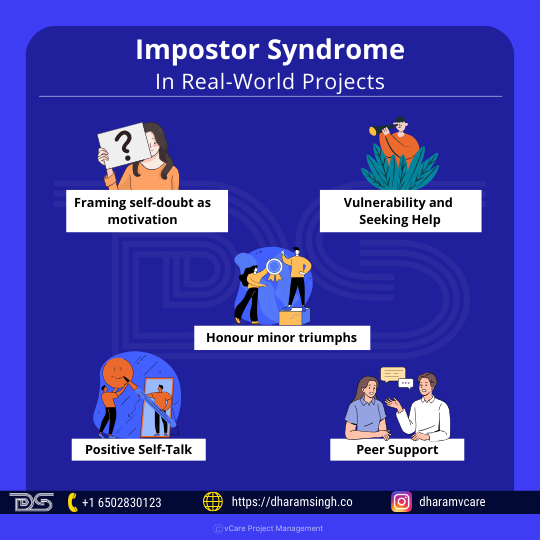
Impostor Syndrome in Real-World Projects
- Framing self-doubt as motivation: Using one’s self-doubt to increase motivation for job performance and preparation.
- Vulnerability and Seeking Help: Seek help in changing the story of impostor syndrome.
- Honour minor triumphs: Divide large objectives into small steps to promote steady progress and self-assurance.
- Positive Self-Talk: Transitioning from self-deprecation to self-support.
- Peer Support: You can become less isolated and more understanding by speaking with others who have gone through the same thing.
Key Tactics for Overcoming Impostor Syndrome
- Recognize and categorize thoughts to detect impostor syndrome.
- Maintain a success journal to document accomplishments.
- Reframe failure as learning opportunities.
- Establish a growth mindset to shift from fixed to improvement-oriented.
- Seek mentorship for insight, encouragement, and constructive criticism.
Cultivating Resilience: The ‘Refuse to Lose’ Mentality
One of the most sought-after and essential traits in the fast-paced workplace of today is resilience. Professional competence in showcasing quicker adaption results in “refusing to lose” mindset in the face of adversity. Resilience is often top-driven with intentional and persistent efforts and the organization’s culture in accepting the change to sustain and overcome hurdles while focusing on long-term success.
The “refuse to lose” mentality implies an unwavering will to achieve one’s goals despite setbacks. It is distinguished by a mindset that sees problems as chances for progress and failures as temporary obstacles rather than insurmountable barriers. This mentality does not mean a steadfast rejection to accept failure, but rather a reluctance to let it define one’s journey. People with this mindset use a proactive, problem-solving attitude, modifying their techniques while remaining focused on their goals. This approach is crucial for professionals in leadership positions including project managers, entrepreneurs, and team leaders. It builds confidence, motivates teamwork, and allows people to manage challenging circumstances with clarity and resolve.
Developing a Resilient Mindset
- Accept failure as a learning experience
Resilience individuals view failure as a learning opportunity, reducing anxiety and promoting continuous progress, thereby transforming it into a stepping stone for success.
- Practice emotional regulation
Emotions need to be handled in a professional manner under stressful conditions. Identifying, understanding, and controlling emotions to respond positively is the essence of emotional regulation. For example, a leader confronted with a project delay may first experience annoyance or fear. Instead of responding impulsively, individuals might pause, analyze the circumstance, and take sensible action to resolve the problem. This calm approach not only helps to address problems but also sets a good example for the team.
- Concentrate on incremental progress
Breaking down big goals into smaller, easier-to-accomplish chores might help you feel more in control. This method generates momentum and confidence, allowing individuals and teams to concentrate on making steady progress. For example, a team working on a large-scale product launch might establish goals for each phase and celebrate little success along the way. Incremental achievement fosters the idea that the final objective is feasible.
- Create a Reliable Support Network
A strong support system can frequently help to boost resilience. It is essential to surround oneself with coworkers, mentors, or peers who can offer direction, support, and critical comments. When leaders encourage cooperation and support among their teams, they create an environment in which resilience becomes a common value. For example, an organization founder experiencing financial issues may seek strategic assistance from their advisory board, building on their aggregate knowledge and expertise.
- Adopt a growth mindset
Professional competence with experience, is essential for fostering resilience. This mentality encourages people to see problems as chances to learn new abilities and maximize their potential. Leaders with a growth mentality encourage their staff to accept change, take measured chances, and innovate even in uncertain situations.
Inspiring Teams Through Resilience
- Manage with transparency and optimism
Resilient leaders motivate their people by combining openness about obstacles with optimism about solutions. Acknowledging obstacles but remaining confident in the team’s capacity to overcome them fosters trust and drive. For example, a project manager handling resource limits may openly address the situation with their team while showing faith in their team’s ability to solve problems together. This strategy enables the team to face difficulties straight on.
- Promote a solutions-oriented culture
A solutions-oriented culture encourages teams to consider potential rather than problems. Leaders may help their teams explore new ways and cooperate to overcome problems. For example, a logistics team dealing with supply chain problems can collaborate to find alternate suppliers or adapt delivery timetables. This method guarantees that obstacles are faced with proactive problem solutions rather than defeatism.
- Empower team members
Empowering team members to take ownership of their roles promotes responsibility and confidence. When people feel trusted to make decisions and contribute to solutions, they are more inclined to face obstacles with grit. For example, a leader who delegates decision-making authority to their team amid a crisis not only fosters trust, but also enhances the team’s capacity to adapt and persist.
- Acknowledge Success and Effort
Acknowledging minor accomplishments boosts perseverance and self-confidence. Celebrating success requires praising effort and commitment, and a team feeling valued is more likely to remain resilient and motivated amidst problems.
Resilience’s Impact on Long-Term Achievement
Resilience in the face of hardship is all about limiting the damage and being able to swiftly resume routine. Long-term success in any field requires a culture of change acceptance, which resilience promotes.
Resilience as a Path to Success
Cultivating a “refuse to lose” mindset is critical for overcoming challenges and establishing lasting success. Individuals may acquire the resilience required to confidently manage obstacles by viewing failure as a learning opportunity, exercising emotional regulation, and having a growth attitude. Leaders who exemplify and promote resilience motivate their colleagues to continue, creating an environment of hope and resolve. Finally, resilience is not about avoiding obstacles, but about growing stronger with each one, ensuring that neither individuals nor teams lose sight of their ability to achieve.
Authenticity over Pretence: Beyond ‘Fake It till You Make It’
The “fake it till you make it” tactic, on the other hand, creates short-term confidence under challenging conditions but has long-term risks. In contrast, the “original” method makes one rely on long-term confidence and trust and gives the same person effective leadership. The strategy is better compared to the latter for counteracting impostor syndrome.
Examining the Limitations of ‘Fake It Till You Make It’
- Superficial Confidence and Emotional Burnout
“Faking it” frequently results in a reliance on external validation rather than actual self-confidence. Over time, the strain to maintain a front can lead to emotional depletion and worsen impostor syndrome.
According to Frontiers on Burnout and Remote Work Stress study published in Psychological Bulletin, hiding actual sentiments or actions to fit into work situations frequently leads to stress and poor job satisfaction.
- Loss of trust in leadership
Leaders who use a “fake it” strategy may fail to develop true relationships with their employees. Trust is the foundation of effective leadership, and perceived inauthenticity can undermine trust. According to Harvard Business Review study: How Transparent Should You Be with Your Team, employees are more inclined to interact with executives who are vulnerable and transparent than those who are too polished or fake.
- Missed Opportunity for Growth
Pretending to know everything may prevent people from seeking help or realizing that they need to improve, which will hinder personal and professional development. A Forbes study on leadership characteristics found that knowledge gaps encourage collaborative problem-solving and foster a culture of continuous learning.
Promoting Authenticity as a Key to Sustainable Leadership

Promoting Authenticity as a Key to Sustainable Leadership
- Encouraging vulnerability
Authentic leaders are open about their shortcomings and share their learning processes with their people. Vulnerability humanizes leaders, resulting in stronger ties and greater respect.
- Self-awareness
Professionals can improve their self-understanding through strategies such as self-reflection or 360-degree feedback, which require self-awareness and acceptance of both personal strengths and weaknesses.
- Developing Confidence Through Mastery, Not Pretence
Authentic confidence is generated via technical mastery and actual successes, not a superficial display of ability. This method guarantees that confidence remains resilient under pressure.
- Promoting Open Dialogue in Teams
Leaders who value authenticity may encourage their people to communicate ideas and concerns without fear of being judged. This fosters a culture of psychological safety, increasing creativity and productivity.
While “fake it till you make it” might provide brief comfort from self-doubt, its drawbacks frequently exceed its advantages. Authenticity, from awareness and vulnerability to honest self-confidence, is much better support for sustainable growth into professionals and effective leaders. A leader who owns his true identity also eliminates impostor syndrome in his life and inspires their teammates with trust, loyalty, and innovation.
The Silver Lining: Impostor Syndrome and Team Dynamics
Unexpected advantages that may enhance workplace dynamics are offered by impostor syndrome, though it is frequently perceived as an unpleasant experience. For individuals suffering from impostor syndrome, interpersonal connections can be improved and contributory roles to cohesive, high-performing teams can be accomplished through the cultivation of self-awareness, empathy, and a collaborative mentality. This viewpoint changes the narrative, emphasizing how impostor qualities may generate unique chances for team growth and success.
How Impostor Syndrome Promotes Collaboration and Empathy?
- Increased Empathy by Sharing Vulnerabilities
Individuals suffering from impostor syndrome are frequently acutely aware of their hardships, which makes them more sympathetic to the difficulties of others. This increased sensitivity promotes a friendly workplace atmosphere.
According to Frontiers: Organizational Psychology, leaders who freely admitted their fears were more likely to foster trust and boost team morale. Teams led by compassionate people expressed greater levels of pleasure and engagement.
- Promoting Inclusion and Diverse Perspectives
Impostor syndrome can make people more open to comments and suggestions from their coworkers. This transparency promotes inclusion and different contributions within teams. McKinsey & Company study on Psychological Safety shows that psychological safety, which is typically associated with empathy and vulnerability, has a favorable influence on innovation and problem-solving in diverse teams.
- Developing a Culture of Continuous Learning
People with impostor syndrome frequently want to improve themselves via continual learning. When incorporated into teams, this approach may foster a culture of self-improvement and skill development.
According to a Harvard Business Review article on “Growth Mindset”, leaders who embrace a growth mindset inspire their staff to follow accordingly, resulting in long-term team success.
Using Empathy and Collaboration for Team Cohesion
- Establishing Psychological Safety
A culture where expressing self-doubt is viewed as a learning opportunity rather than a sign of weakness may be established by team members and leaders.
- Promoting cooperative problem-solving techniques
Self-doubt is the characteristic aspect of impostor syndrome, driving people to seek feedback from others frequently. This can naturally result in more collaborative problem-solving and sound decision-making being made.
- Creating stronger team bonds
Shared experiences with impostor syndrome can bring team members closer together and promote unity. Teams that bond over common struggles are frequently more cohesive and resilient.
Impostor syndrome, while hard, provides unique chances to improve workplace relationships via enhanced empathy, collaboration, and a desire to learn. Leaders may use psychological safety to establish cohesive and resilient teams. Turning impostor syndrome’s perceived “weakness” into a strength benefits both people and the company as a whole.
Support Systems: Mentorship, Leadership, and Organizational Roles
Impostor syndrome thrives in circumstances that lack proper support, making mentorship and leadership critical in resolving this common issue. Organizations that use defined frameworks to actively foster confidence and progress might turn impostor syndrome into a professional development opportunity.

Impostor Syndrome – Support Systems: Mentorship, Leadership, and Organizational Roles
The role of mentorship and leadership
- Assistance with mentoring as a catalyst for confidence
Mentors provide a secure environment for mentees to discuss their fears and acquire perspective.
The Harvard Business Review emphasizes the value of mentors who aggressively confront negative self-talk and assist mentees in recognizing their accomplishments.
- Leadership Styles That Prevent Impostor Syndrome
Transformational leaders, who inspire and motivate by creating psychological safety, are very good at addressing impostor syndrome.
Developing organizational frameworks for confidence and growth
- Transparent Feedback Systems
Constructive, actionable criticism encourages employees to see mistakes as learning opportunities rather than failures.
- Inclusive and supportive cultures
Inclusivity training and DEI (Diversity, Equity, and Inclusion) activities create an atmosphere in which employees feel valued for their individual contributions.
A Deloitte survey found that firms with effective DEI frameworks have greater employee satisfaction and lower instances of impostor syndrome.
Future Directions: Addressing Impostor Syndrome in an Evolving Workplace
As workplaces evolve, businesses must develop methods to handle the shifting environment of impostor syndrome, which is impacted by hybrid work arrangements and developing technology.
Hybrid Work Models and their Impact
- Remote Work: A Double-edged Sword
While remote work provides flexibility, it can also exacerbate feelings of isolation and self-doubt owing to decreased visibility and acknowledgment. A Buffer: State Of Remote Work 2023 poll on remote work found that 20% of remote workers felt detached from their teams, aggravating impostor emotions.
- Leveraging Technology for Inclusion
When utilized properly, virtual platforms such as Slack and Zoom may promote improved team communication and cooperation.
Tools like as 360-degree feedback systems also enable remote workers to obtain continuous recognition for their achievements, eliminating impostor tendencies.
Future Directions: Addressing Impostor Syndrome in the Evolving Workplace
Organizations have additional hurdles in dealing with impostor syndrome as workplaces shift due to hybrid models and technology improvements. The changing nature of work, marked by distant cooperation, digital advancements, and changed employee expectations, needs proactive methods to reducing self-doubt and creating a supportive atmosphere.
How hybrid work models influence impostor syndrome?
- Remote Work Amplifies Isolation
Hybrid work models can increase impostor syndrome by amplifying isolation, lack of visibility, and limited feedback loops. Remote workers often feel that their efforts are not recognized, which increases self-doubt. According to a Buffer: State Of Remote Work 2023 study, 20% of remote workers experience loneliness, and 14% face communication challenges, which are exacerbated by remote work.
- Challenges in Building Team Cohesion
Hybrid teams face challenges in collaboration opportunities, leading to remote members feeling undervalued. A 2022 Microsoft Work Trend Index report revealed that while 58% of employees thrive in hybrid environments, others struggle to demonstrate their value.
- Opportunities for Flexibility and Personal Growth
Hybrid work provides employees with flexibility, allowing them to work at their own pace, reducing stress and promoting a positive work-life balance, as evidenced by Gallup’s 2022 data.
The Impact of Technology on Impostor Syndrome
- Digital Tools for Recognition and Feedback
Technology can assist overcome communication gaps in mixed work environments by enabling real-time recognition and constructive feedback. Managers may use tools such as Slack, Microsoft Teams, and Culture Amp to recognize employee successes and address problems on a regular basis.
- Overwhelming Pace of Digital Change
The rapid expansion of digital technologies can overwhelm employees, especially those who believe they lack the necessary qualifications to stay up, increasing impostor syndrome. Professionals are increasingly concerned about job displacement and inadequacy as their dependence on artificial intelligence and automation grows.
Preparing Organizations and Individuals Ready for Future Challenges
Organizations should create inclusive hybrid work environments, ensuring equity in opportunities, feedback, and recognition for both in-office and remote employees. Implementing hybrid-friendly policies and prioritizing inclusive collaboration tools can help. Employee well-being investment, including mental health support and resilience training, can be a great way to fight impostor syndrome.
Leadership development for a changing workforce is also very important, with programs like Adobe’s “Check-In,” which encourages managers to hold monthly feedback sessions. Leverage technology for personalized growth, such as AI-driven career development tools, that help identify skill gaps and tailor learning experiences. Virtual reality training programs will become a future trend in building confidence and reducing feelings of inadequacy.
Hybrid work poses both challenges (e.g., isolation) and opportunities (e.g., flexibility), which influences impostor syndrome. Technology may both exacerbate self-doubt and provide instruments for feedback, acknowledgment, and skill growth. Organizations must use inclusive practices, mental health programs, and new technology to prepare people for future workplace dynamics.
Conclusion: Addressing the Hidden Challenge of Impostor Syndrome in Project Management
Impostor syndrome is a serious but largely silent difficulty for project management professionals working in high-pressure situations. Individuals and organizations may lessen the effects of the pandemic by recognizing its core causes, treating its psychological toll, and developing resilience tactics.
Recognizing and addressing impostor syndrome in project management
The first step toward resolution is to recognize impostor syndrome’s common impact on project managers working in high-stakes contexts. The ongoing need to manage several obligations frequently causes self-doubt, which leads to stress and poor performance. Awareness and acknowledgment of these sentiments are essential for dissolving their influence.
Balancing Confidence with Continuous Growth
To combat impostor syndrome, professionals must develop confidence and a development mentality. Confidence promotes self-assurance in decision-making, but an approach to growth allows project managers to see setbacks as chances for learning. Together, these characteristics prepare people to overcome failures with optimism and tenacity, eventually encouraging personal and team success.
Leveraging Real-World Strategies and Resilience
Real-world instances show that impostor syndrome may be successfully addressed with purposeful effort. Resilience, shown as a “refuse to lose” mindset, enables professionals to persevere in the face of adversity. This mindset not only boosts individual morale, but it also encourages teams to take similar approaches to problem resolution.
Promoting authentic leadership
The era of “fake it till you make it” has demonstrated its limitations. The key to long-term success is sincerity. Project managers may strengthen their teams’ connections by accepting vulnerability and concentrating on effective leadership. Authenticity also weakens impostor syndrome by relieving the urge to present perfection and allowing individuals to lead with integrity.
Impostor Syndrome’s Impact on Team Dynamics
Interestingly, impostor syndrome can have a positive outcome. When correctly addressed, it promotes empathy and collaboration, which enhance team interactions. Leaders and team members who freely communicate their difficulties with self-doubt foster a culture of mutual support and understanding, which improves team cohesiveness and productivity.
The Value of Support Systems and Organizational Roles
Mentorship and empathetic leadership are critical in overcoming impostor syndrome. Mentors help professionals overcome self-doubt, whereas leaders foster an environment of psychological safety. Organizations, too, contribute by establishing systems that promote open communication, frequent feedback, and opportunity for advancement.
Looking Forward: Adapting to a Changing Workplace
As hybrid work patterns and technology breakthroughs transform workplaces, impostor syndrome gains new dimensions. Remote setups may increase isolation, and fast technical advancements can foster feelings of inadequacy. To better prepare individuals for future challenges, forward-thinking firms must embrace inclusive policies, leverage technology for development, and prioritize mental health support.
Empowering Project Managers for Success
Impostor syndrome is not a hurdle, but rather a hidden difficulty that, when handled, may unleash immense potential. Using self-awareness, resilience, honesty, and organized support, project managers may overcome self-doubt and lead confidently. At the corporate level, cultivating an inclusive and continuous growth culture guarantees that workers survive and, more importantly, thrive in their positions. These concepts form a solid basis for long-term success in project, program, and portfolio management.
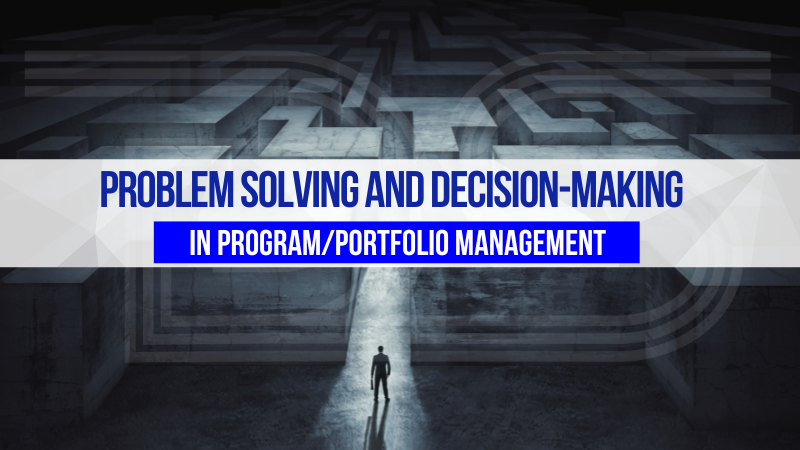
by DharamCW | Oct 28, 2024 | General
Program/portfolio managers must make significant and minor decisions in the ever-changing project management environment. In many instances, their judgments and actions due to their more critical decisions may significantly influence their well-being and the prospects of clients and team members. Moreover, such decisions can impact the very nature of our jobs and even the lives of others who rely on them.
As equal to decision-making, problem-solving skills are essential in project management. Problem-solving is a project management skill that combines creative thinking and strong analytical abilities to assist effective problem solutions. This skill allows the project leader to look at challenges from a different angle and assist in designing and implementing successful solutions for making great decisions.
It’s easy to understand how, in problem-solving, recognizing simple solutions to complicated challenges might benefit the project and the company. Still, not all competent Project Leaders are capable of doing so. To be an effective problem solver and decision maker, the program/portfolio manager must possess specific skills and techniques to manage the project successfully.
Understanding the Decision Making Process in Project Management
All managers and other interested stakeholders must have a thorough grasp of decision-making in project management. The project will only then be able to progress toward the final delivery phase while maintaining the established timelines. The project runs a significant risk of stagnating or moving extremely slowly in this absence.
However, many businesses need help on several fronts because they need to recognize the value of decision-making in their management teams.
A McKinsey survey found that roughly 80% of professionals thought their firms’ decision-making processes could have been more efficient. Furthermore, the firms that demonstrated superior decision-making skills and topped the survey had better financial and performance outcomes.
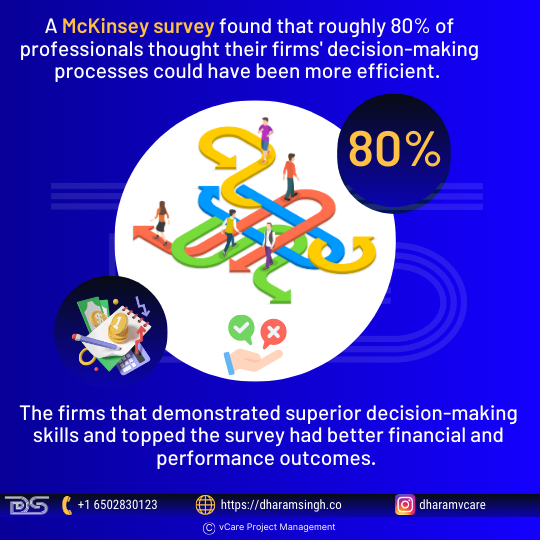
Why Efficient Decision-Making Matters for Firms
Decision-Making Types in Program/Portfolio Management
Decisions need to be made regularly in project management. Most are minor, but others are significant and will determine whether the project succeeds or fails. The same applies to program/portfolio management. Final choices can be reached using either an intuitive or logical method or a combination of the two. More intricate conclusions typically need a more formal, systematic approach incorporating intuition and reasoning. Not all decisions are the same. Management must make many decisions during a project, and each decision-maker is unique. The most common ones are listed below:
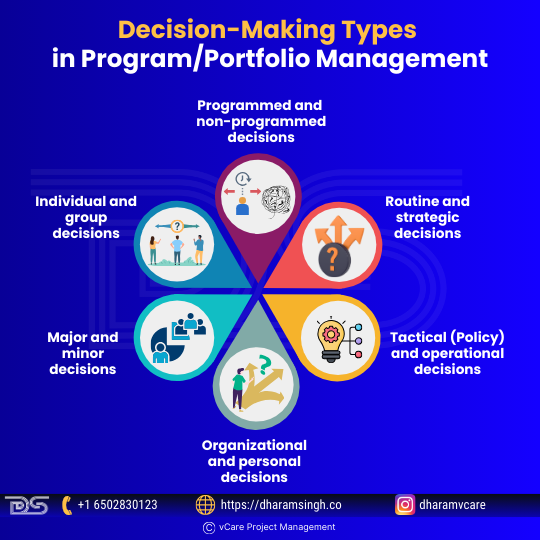
Decision-Making Types in Program/Portfolio Management
- Programmed and non-programmed decisions
Programmed decisions are concerned with problems of a repetitive nature or routine type matters. For example, decisions of this type may pertain to purchasing raw materials, granting leave, and supplying goods to the employee. Non-programmed decisions are made in challenging situations with no clear solution. These decisions need more attention, resources, and time and are usually made at a higher level.
- Routine and strategic decisions
Routine decisions affect the overall operation of a project and can be made rapidly. Within the broad policy framework of the project manager or the organization, ample powers are granted to lower ranks to make these decisions. However, strategic decisions are essential and affect objectives, organizational goals, and other important policy matters. These decisions usually involve a program’s orientation or huge investments in portfolios, are non-repetitive, and are taken after careful analysis and evaluation of alternatives.
- Tactical (Policy) and operational decisions
Portfolio managers make policy decisions that have a long-term impact on the functioning of the concern. For example, decisions regarding how many projects can be run each time according to the budget are policy decisions. On the other hand, operational decisions relate to the day-to-day functioning or operations of the business. Middle—and lower-level managers make these decisions. For example, decisions concerning the payment of bonuses to employees are operational rather than policy decisions.
- Organizational and personal decisions
When an individual decides their responsibilities and tasks within the project, it is an organizational decision. But, if the individual decides on personal matters, it’s a personal decision. The authority to make organizational decisions may be delegated, whereas personal decisions cannot.
- Major and minor decisions
A decision related to increasing the number of resources by 50% is a major decision. A minor decision, for example, is that the superintendent can purchase office stationery.
- Individual and group decisions
When an individual decides within an organization, it is known as an individual decision. However, when it comes to more crucial decisions, more stakeholders need to engage and assist in making a decision. Therefore, it is interesting to investigate in which cases a project manager should involve other project members.
Decision-making Tools and Techniques
Project managers frequently employ additional measures to support the validity of their decisions. While the fundamental concepts remain the same, hundreds of distinct ways and tools are available. A mixture of these strategies can also be employed to make better decisions. Project managers would benefit from knowing which are appropriate and applicable in any given situation.
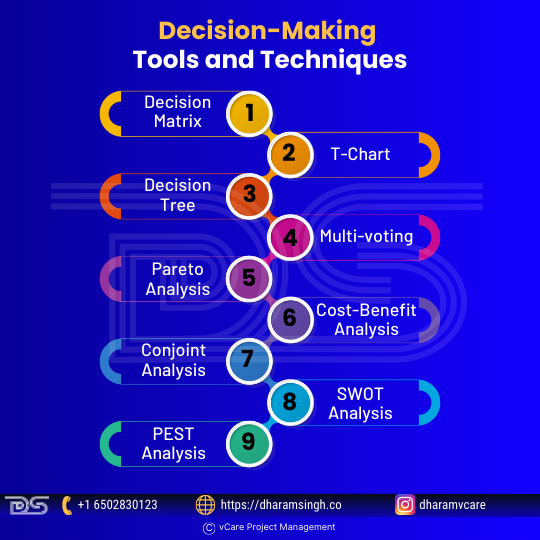
Decision-making Tools and Techniques
- Decision Matrix: A decision matrix examines all of a choice’s possibilities. When utilizing the matrix, create a table with all the alternatives in the first column and the criteria influencing the decision in the first row. Users then rate each choice and choose which criteria are most important. After that, a final score is calculated to determine the best option.
- T-Chart: This chart analyzes the benefits and drawbacks of the alternatives. It guarantees that all of the advantages and downsides are considered when deciding.
- Decision Tree: This is a graph or model for assessing each option and its outcomes. This approach is also used for statistical analysis.
- Multi-Voting: This is utilized when multiple people decide. It helps narrow down many possibilities to a smaller one that leads to the final decision.
- Pareto Analysis: This technique is used when making many decisions. This analysis aids in selecting which decisions should be made first by calculating which ones will have the largest overall impact.
- Cost-Benefit Analysis: This strategy assesses the financial implications of each feasible alternative to arrive at the most economical conclusion.
- Conjoint Analysis: Business leaders use this strategy to assess consumer preferences when making decisions.
- SWOT Analysis: This planning tool examines SWOT (strengths, weaknesses, opportunities, and threats).
- PEST Analysis: PEST, which stands for political, economic, social, and technical aspects, can help decision-making and timing by analyzing external factors. This method takes current trends into account to forecast future ones.
Importance of Decision-Making
Decision-making is an acquired skill rather than an inherent one that is in high demand in the workplace. However, employers consider it an appealing trait as it signifies a good leader. Therefore, demonstrating your decision-making abilities can help you advance your career and accomplish company objectives and goals.
Here are some of the benefits of making correct decisions:
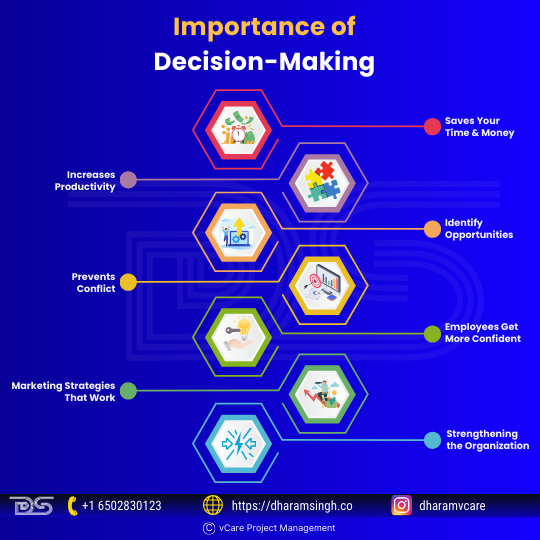
Importance of Decision-Making
- Saves Your Time & Money
Ineffective decision-making requires some time and depletes the motivation of those engaged. The less time you waste making rapid decisions, the better. When it comes to running a business, time is money. Wasting time is the same as wasting money.
- Increases Productivity
When management excels at making decisions and developing good ones, it will boost the workforce’s productivity. Employees will be motivated, for one thing, since they know where the organization is heading. They will strive with the conviction that their efforts will succeed. All time is preserved because the management team is convinced that their activities will correctly guide their organization.
- Identify Opportunities
The key is to recognize the opportunities in front of you and be able to act on them. If there is a great demand for a product in the market and your firm can offer it, wrong or delayed decision-making may prevent you from focusing on it. On the other hand, poor decision-making can make opportunities appear non-existent.
- Prevents Conflict
A manager’s failure to make strong, fair decisions can lead to workplace conflict. Conflicts in the lower tiers also occur when management needs to be more assertive and leave more decisions to their employees. Good decision-making skills can prevent employee conflicts regarding which idea is better for their team or how to maintain a project.
- Employees Get More Confident
Project leaders can become role models and show their employees they are good decision-makers. As a result, employees will trust and follow them confidently, even in the darkest times. When their staff feels that they trust their decisions at every moment, they are more likely to develop new innovative ideas that could benefit the overall business.
- Marketing Strategies That Work
Several critical considerations must be made when implementing successful marketing campaigns. Decision-making is the most important factor in developing strategies and making them stand out. No matter how good the products or services are, the firm will only reach its full potential if it can effectively advertise its brand.
- Strengthening the Organization
Everyone has an equal right to participate in the management of the organization. This aspect fosters a spirit of teamwork and solidarity among those who work there, improving the organization’s overall productivity and strengthening its general structure. Decision-making allows individuals working in an organization to convey their ideas equally.
Decision-making and its impact on problem-solving
The importance of decision-making in problem-solving is apparent and an essential component of efficient project management. A project manager’s capacity to make sound decisions and solve problems correctly is critical since it influences organizational functioning. Problem-solving and decision-making are sometimes inextricably linked; one must better decide to solve a problem.
Problem-solving is a key skill that makes one an excellent project leader. Problems are unavoidable when it comes to project management. Because we all encounter similar scenarios in our everyday lives, what makes a difference is knowledge and how well we use it to tackle a present or looming problem. In project management, problem-solving and resolution are strategic processes. As a result, one won’t be able to master that talent overnight. Instead, it requires incremental learning, using a framework, and preserving some critical factors.
Why are problem-solving skills necessary?
When potential employers discuss problem-solving, they aim to assess how team members use this talent to assist decision-making in the company’s day-to-day operations. Here are four reasons why problem-solving skills are vital in the workplace:
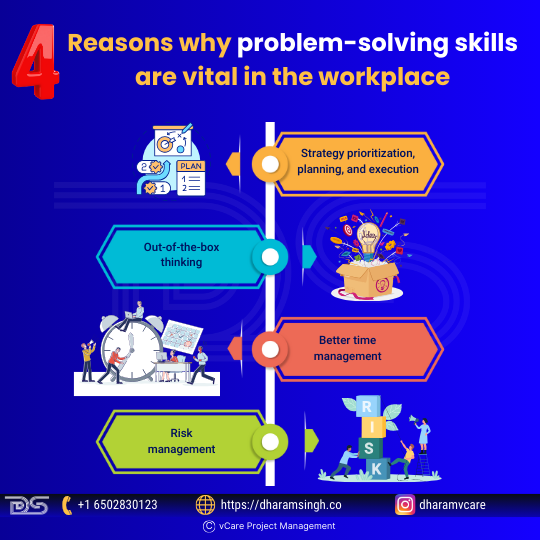
Why are problem-solving skills necessary?
- Strategy prioritization, planning, and execution
Efficient problem solvers may thoroughly examine consumer requirements and devise a strategy that allows them to give outstanding service to their intended audience. Their expertise is in simplifying procedures by eliminating bottlenecks.
- Out-of-the-box thinking
Problem-solving and creative thinking are inextricably linked. Finding a dynamic and innovative solution to a problem is not a matter of finding an instant solution but a dynamic and innovative solution. This mindset assists the company in staying ahead of the curve and gradually improving the workforce’s competence.
- Better time management
When an issue emerges, it must be resolved as soon as possible. Employees with strong problem-solving abilities are laser-focused on what is critical to the organization, can roll with the punches, and can meet tight deadlines.
- Risk management
Effective planning is a necessary problem-solving ability. Problem solvers may respond rapidly to short-term circumstances while keeping an eye on the future. Their positive approach toward learning agility enables them to foresee future challenges based on prior experiences, industry trends and patterns, and current events.
Problem-solving Techniques
Complex problems might be challenging to solve, yet difficulties can be addressed when the correct tools are used. Aside from sophisticated management tools, here are some tools and technologies that can help with problem-solving approaches in your everyday work.
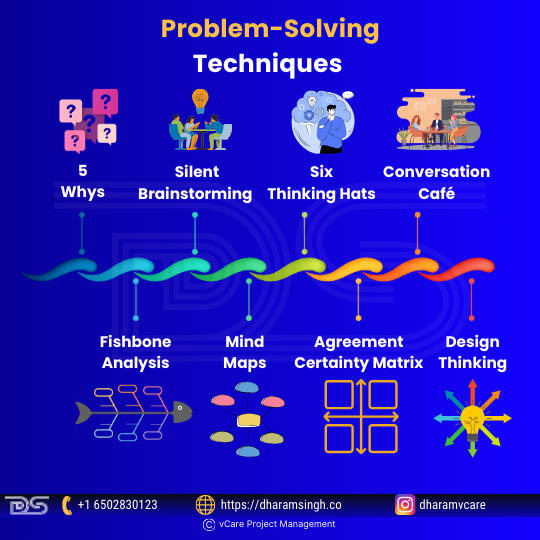
Problem-solving Techniques
- 5 Whys – Understanding the problem better is a wonderful strategy to find the core cause.
- Fishbone analysis – used to visualize the fundamental causes of an issue. Simple to use in conjunction with ‘5 Whys’ or ‘Mind mapping’ to brainstorm and discover the source and impact of any problem.
- Silent brainstorming – allows everyone to engage in idea generation since the loudest and quietest persons will contribute equally. This technique is useful because everyone’s point of view is equally valid.
- Mind maps – are organized visual representations that allow one to exchange ideas, thoughts, and solutions like your brain does. You immediately describe the issues, discuss new ideas, and eventually reach a team agreement that can lead to a successful solution.
- Six thinking hats – This technique allows your team to approach challenges from several perspectives, concentrating on facts, creative ideas, or why some solutions may not work.
- Agreement certainty matrix—another fantastic visual tool for brainstorming issues and challenges. It categorizes them as simple, complicated, complex, or chaotic domains to help teams agree on what technique should be utilized to handle the real problems impacting them.
- Conversation café: This allows the team to have constructive conversations with less argument and more active listening. The problem is addressed in rounds of dialogues until a consensus is reached on the best problem-solving technique.
- Design thinking: When you’re stuck for new ideas, the 5-step approach will help you empathize with the problem, then define and create new concepts before prototyping and testing them.
What are the critical problem-solving skills?
Problem-solving skills enable firms to seek and recruit intellectually equipped personnel who can handle anything their professions throw at them. Problem solvers can watch, assess, and act quickly when the situation demands it- without negatively impacting the business. The following are the top problem-solving skills in the workplace:
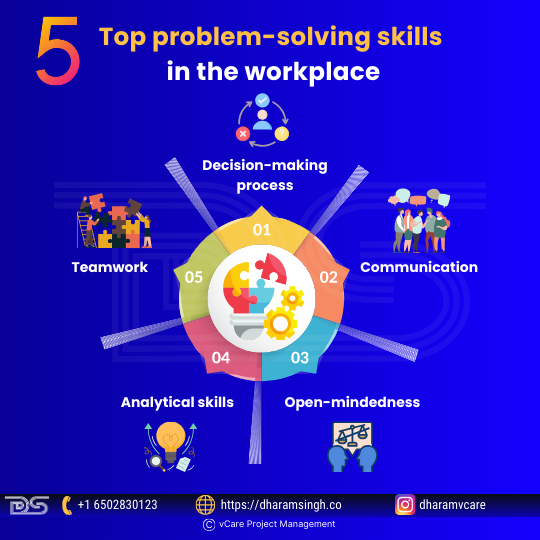
Top problem-solving skills in the workplace
- Decision-making process
Problem-solving requires the ability to make decisions. One can only solve it if one fully comprehends the issue and decides to take action. Decision-making abilities enable experts to rapidly choose between two or more solutions after weighing the benefits and drawbacks of each.
- Communication
Communicating the problem and offering remedies vocally and in writing is an art in and of itself. However, proper communication ensures that solutions are implemented successfully and that all parties engaged in the disagreement agree.
- Open-mindedness
Open-mindedness is the readiness to explore new ideas and look at things from a new viewpoint. When faced with an issue, consider all of its viable solutions. Being curious and observant allows one to be a better problem solver.
- Analytical skills
Almost all problem-solving scenarios need analysis, such as predicting, critical thinking, or troubleshooting. Analytical skills allow one to comprehend the situation better and generate effective answers based on facts and data.
- Teamwork
Collaboration is essential for keeping communication lines open, problems cooperatively addressed, and the team aims before personal ambitions.
Team dynamics are important in problem-solving because they allow one to work together with others toward a common objective.
Final Thoughts
The majority of problems start modestly. Creative program/portfolio managers are responsible for finding solutions as quickly as feasible. The longer they wait, the worse the situation will get.
They may break out of that cycle with a strategic problem-solving framework and quickly find solutions to difficulties using ideal project management automation technology. However, making decisions is crucial to solving problems. Making decisions may be a painstaking process in project management. However, the decisions made inside the team significantly impact a project’s success.
In the future of employment, net new jobs will be created at the same pace as dying jobs. Human talents such as creativity, decision-making, problem-solving, invention, and critical thinking will become more in demand as technology replaces employment requiring repetitive and boring operations. Organizations that get a head start on measuring these human talents in their workforce now and provide strategic learning and development opportunities to upskill them will gain a competitive edge as we enter the Fourth Industrial Revolution.
Jobs we will never see coming will rise rapidly in the future of work (or what many call “The Fourth Industrial Revolution”). The “proper” professional path or education of an ideal individual for these professions will not be clear. We will need to quantify people’s human talents to position them in positions; not only are these skills transferable across unconventional career choices, but these distinctive human skills will also be protected against automation.
Thus, advanced certifications like PMP®, Agile, PgMP®, and PfMP® certifications can help one develop project management skills, be a good problem solver, be a more competitive candidate for positions, and be a successful project leader. In today’s competitive business world, one must be skilled and experienced to succeed and grow one’s career.
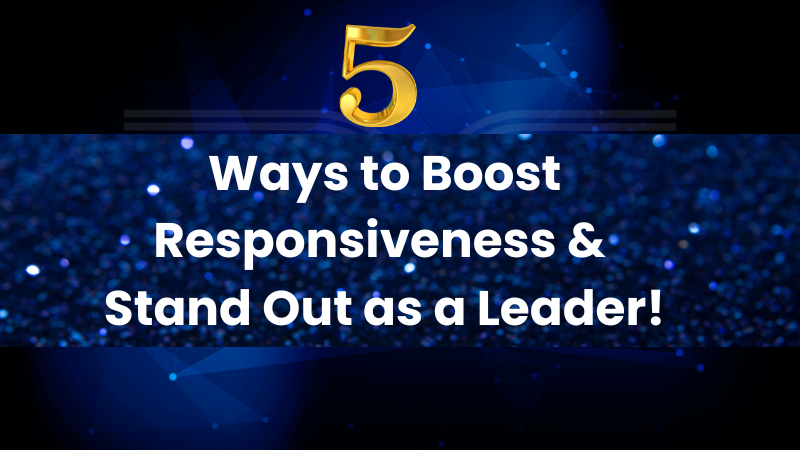




















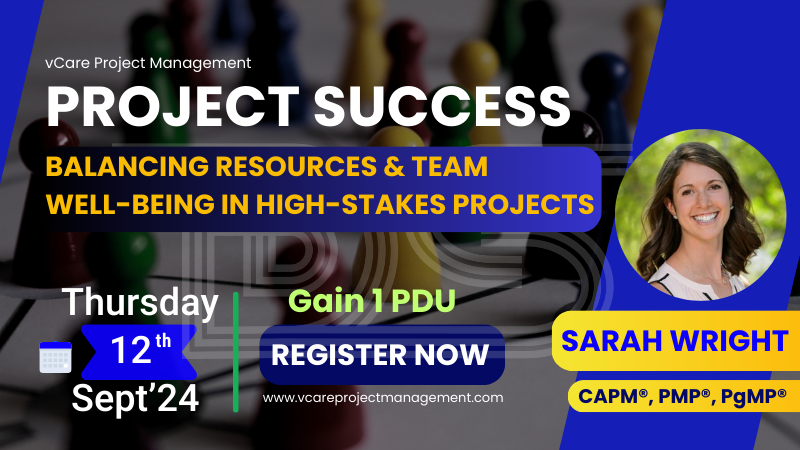



Join us for an insightful webinar hosted by vCare Project Management, featuring Sarah Wright, PMP, PgMP, a Senior Technical Project Manager at Specialized Bicycle Components based in Morgan Hill, California, USA. In this webinar, Sarah will cover essential topics for senior project, program, and portfolio management professionals.
Session discussion topics include the following:
– Strategies for Maintaining Team Morale and Productivity During High-Pressure Projects
– Pivoting Project Management Strategies to Enhance Team Well-being
– Leveraging Resource Management Tools for Project Success
– Measuring the Impact of Resource Allocation on Project Outcomes and Team Satisfaction
– Integrating Agile Principles into Resource Management Practices
– Proactively Identifying and Addressing Root Causes of Stress in Project Teams
By attending, you’ll gain insights from Sarah’s experiences and earn 1 Professional Development Unit (PDU) and a special discount code for upcoming PMP, PgMP, and PfMP programs. Take advantage of this opportunity to enhance your skills and save on future programs.
🔗 Reserve your spot now: https://bit.ly/4fJdX0c
Session Date: Thursday, 12th September 2024
Session Time: 10:00 AM – 11:00 AM (AKDT) / 11:00 AM – 12:00 PM (PDT) / 12:00 PM – 01:00 PM (MDT) / 01:00 PM – 02:00 PM (CDT) / 02:00 PM – 03:00 PM (EDT) / 03:00 PM – 04:00 PM (BRT) / 07:00 PM – 08:00 PM (BST) / 08:00 PM – 09:00 PM (CEST) / 09:00 PM – 10:00 PM (AST) / 10:00 PM – 11:00 PM (GST)